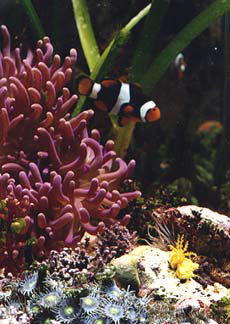![]()
![]()

The seagrass aquarium houses a pair of captive-bred Solomon Island black percula clownfish (Amphiprion percula) together with a host anemone (Macrodactyla doreensis).
Clownfish - anemone mutualisms
Anemones have stinging cells in their tentacles that are avoided by most
fish, but clownfish develop a protective body mucus that allows them to
swim among the tentacles without being stung. Clownfish derive protection
from predators from this association. In turn, the clownfish protect their
host anemone from butterfly fish and other predators that eat anemones,
and they keep the anemone free of dirt and debris.
The strange sex lives of reef fish
In addition to the mutualistic relationship between clownfish and anemones
described above, clownfish are also interesting in that they change sex
as they mature. Normally, all clownfish start out as males and only change
into females when they reach larger sizes. In the wild, a host anemone will
typically be occupied by a large female, a smaller male, and one or more
genderless juveniles. A pecking order is established in which the female
is dominant, the male is subordinate to the female, and the juveniles are
subordinate to the male and to larger juveniles. The male and female form
a monogamous pair bond that lasts until one member of the pair dies. If
the female dies first, the male rapidly changes into a female, and the largest,
most dominant juvenile becomes a male that pairs up with the newly transformed
female.
Though sex change is rare in freshwater fish, many species of reef fish besides clownfish undergo gender transformations. However, in many of these sex-changing fish species, individuals start out as females and then transform into males. Examples of fish that do this are many of the wrasses, parrotfish, dwarf angelfish, and others. Typically, the ratio of males to females controls these sex changes. For example, in the blue headed wrasses, found on reefs in the Florida Keys and the Caribbean, the largest, dominant fish is a male. If he dies, the largest female from his harem will quickly transform into a male.
These patterns of sex change are called sequential hermaphroditism. Clownfish are protandrous (male first) sequential hermaphrodites, while wrasses and others are protogynous (female first) sequential hemaphrodites.
Some marine fish take these confusing matters of gender one step further. For example, some gobies can change sex and then change back again, depending on the ratio of males and females in the local area. Still other reef fish are simultaneous hermaphrodites. For example, in many of the dwarf seabasses, each fish is functionally both male and female! Some dwarf seabasses form long-term monogamous pairs, which spawn together each evening during the breeding season. In a given night of spawning, members of these pairs will trade off between laying eggs and fertilizing their mates' eggs.